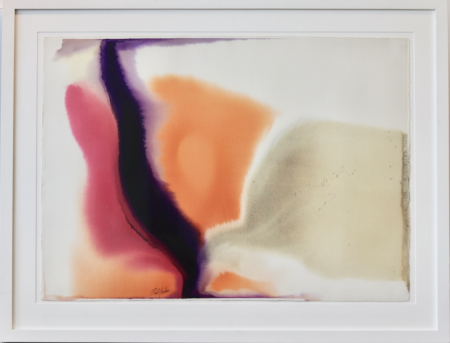Paul Jenkins
(1923-2012)
Paul Jenkins was an American pioneer “Colorfield” Abstract artist and member of the New York School. Jenkins’s innovative practice was characterized by his choice to avoid the paintbrush altogether, instead of allowing pigment to pool, bloom, or roll across the surface of his canvases, guiding the paint with a knife to create fluid fields of color, as seen in his work Phenomena Anderson (1972). “With the smooth organic surface of the ivory, I could use great pressure against the sensitive tooth of the canvas,” the artist said of his process. Born William Paul Jenkins on July 12, 1923, in Kansas City, MO. Jenkins worked at a ceramics factory in his youth, an experience that heavily influenced his tactile methods of painting. He studied at the Kansas City Art Institute and the Art Students League in New York. A close friend of Mark Rothko, Jenkins remained tied to the city even during his move to Paris during the 1950s. His work is found in many major collections.
- Display 15 Products per page
The Art of Paul Jenkins
Paul Jenkins was an American abstract expressionist painter who expanded his talents to work with many mediums. With works like the ethereal beauty of “Phenomena Light” or the dynamic energy of “Phenomena Hurricane,” Jenkins’s art is a testament to his boundless creativity and passion for the craft.
Paul Jenkins Biography
William Paul Jenkins (known as Paul Jenkins) was born in 1923 in Kansas City, Missouri, where he was raised. Jenkins’s innate talent was evident from a young age, as he began experimenting with art at the age of five. As a young man he knew artist Thomas Hart Benton and he was influenced by the Eastern art collection of the Nelson-Atkins Museum.
During his teen years, he moved to Struthers, Ohio to live with his mother and stepfather. After graduating from High School, he served in the U.S. Maritime Service and served in the U.S. Naval Air Corps during World War II. In the late 1940’s, he moved to New York City and studied at the Art Students League of New York with Yasuo Kuniyoshi and Morris Kantor. In the early 1950’s, he traveled to Europe, working for three months eventually settling in Paris, France. From 1955 on, the artist shared his time between New York and Paris.
In the ’50s, Jenkins achieved prominence both in New York and Europe for his early abstractions.Jenkins’ first solo exhibition in the US took place in 1954 at the pioneering gallery of Zoe Dusanne in Seattle. He also had a solo exhibition in New York in 1956 at the Martha Jackson Gallery. He was invited by Jiro Yoshihara to work with Gutai in Osaka; however, but he did not get there until 1964.
In the 70’s Jenkins started to work with sculpture again, something he had done earlier in his career but that he know he focused on. He also started to experiment with collages and watercolor. He continued expanding his artistic repertoire with acrylics and works on paper in the 90’s and 2000’s.
Paul Jenkin’s Legacy
Paul Jenkins eventually died in 2012, just one month before his 89th birthday due to an illness. During his lifetime he contributed a vast array of works working with many different mediums. In addition to his artistic achievements, Jenkins’s impact on the art world extends far beyond his paintings. He was a teacher and mentor to many aspiring artists, sharing his knowledge and wisdom with generations of creatives. His dedication to fostering creativity and innovation serves as a lasting legacy that continues to inspire artists to this day.


